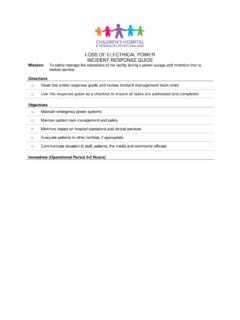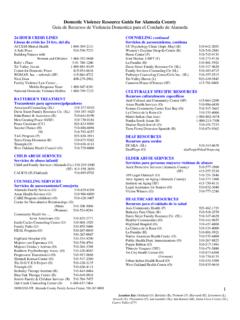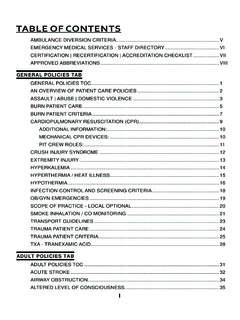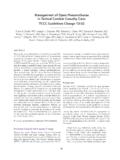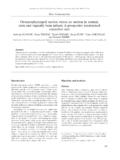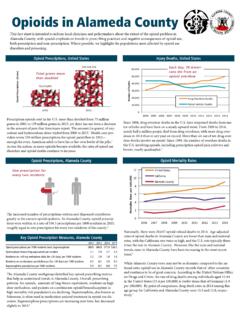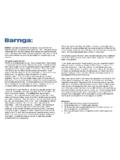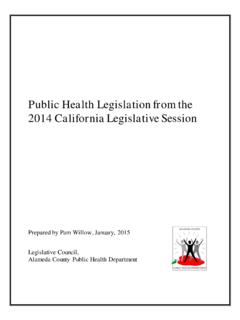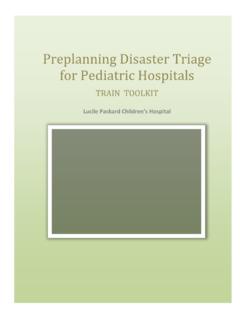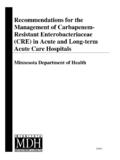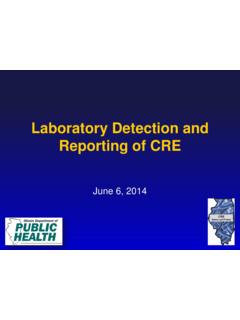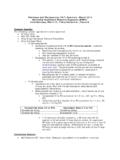Transcription of Caring for Patients with Carbapenem-resistant ...
1 ALAMEDA COUNTY HEALTH CARE SERVICES AGENCY Alex Briscoe, Director PUBLIC HEALTH DEPARTMENT Muntu Davis, MD, MPH, Director, Health Officer Division of Communicable Disease Control and Prevention Erica Pan, MD, MPH, Director & Deputy Health Officer 1000 Broadway, Ste 500 Sandra Huang, MD, TB Controller & CD Controller Oakland, CA 94607 Tel (510) 267-3250 Fax (510) 268-2111 Caring for Patients with Carbapenem-resistant Enterobacteriaceae (CRE) Recommendations for Long-Term Care Facilities (LTCFs) COVER SHEET Date: Fax: To: Email: From: [Sender is exempt from requiring authorization per HIPAA [citation (b)] Thank you for reporting the CRE case(s) at your facility. A Public Health Nurse will be in contact with you for further guidance.]
2 Please begin reviewing this packet, which includes the following documents and guidelines: Recommendations Checklist (enclosed) General Principles of Infection Prevention and Control (enclosed) Environmental Checklist for Monitoring Terminal Cleaning (enclosed) CRE Toolkit (attached) Inter-facility Transfer Form (attached) with Clinical Assessment Tool (enclosed) Under the direction of the Alameda County Health Officer, the recommendations provided are in supplementation to the California State Department of Public Health s recommendations. CONFIDENTIAL INFORMATION The attached material is intended for the use of the individual or organization to whom it is addressed, and may contain information that is confidential, privileged and exempt from disclosure under applicable law.
3 If you are not the intended recipient, you are notified that any use, distribution or copying of this document is strictly prohibited. In the event that you receive this communication in error, please notify us immediately. Thank you. Note: Privacy Rule (HIPAA) permits covered entities to disclose PHI without authorization to public health authorities or other entities who are legally authorized to receive such reports for the purpose of preventing or controlling disease. This includes the reporting of disease, conducting public surveillance, investigations, or interventions. Alameda County Public Health Department Communicable Disease Control and Prevention Communicable Disease Unit 1000 Broadway, Suite 500, Oakland, CA 94607 Phone: (510) 267-3250 Fax: (510) 268-2111 Patient Information Name: Next of kin: DOB: Relationship: Address: Address: Phone: Phone: Comments: Discharge Facility Name of facility: Infection control contact: Complete address: Phone: Fax: Email: Admit date: Discharge date: Director of Nursing: Phone: Fax: Email: Comments: Receiving Facility Name of facility: Infection control contact: Complete address: Phone: Fax.
4 Email: Admit date: Director of Nursing: Phone: Fax: Email: Comments: CRE Definition, for reporting purposes Any Klebsiella spp., E. coli, or Enterobacter spp. resistant to any of the carbapenems (meropenem, imipenem, doripenem and ertapenem) OR Any Klebsiella spp., E. coli, or Enterobacter spp. with demonstrated production of a carbapenemase ( , KPC, NDM, VIM, IMP, OXA-48) by a recognized test ( , PCR, metallo- -lactamase test, modified-Hodge test, Carba-NP) Resources ACPHD Health Alerts/Advisories (including CRE) 2012 CRE Toolkit (CDC) California Department of Public Health (CDPH) Healthcare Associated Infections (HAI) Program Recommendations Checklist Recommendations are subject to change and are only advised as of date recommended Date Recommendation Infection Control Place CRE infected and colonized Patients in private rooms with contact precautions Encourage treating clinicians to limit antibiotic exposure and use of invasive devices Educate affected staff, visitors, and Patients about CRE Carbapenem-resistant Enterobacteriaceae in Healthcare Settings Hand Hygiene Wash Hands thoroughly or use alcohol based hand sanitizers Before entering patient room (even if gloves are used) After removing gloves and exiting the patient room More information and guidance available at Personal Protective Equipment (PPE)
5 To be used by all staff and visitors entering the patient s room All PPE should be available outside the patient s door and donned before entering room All PPE should be properly doffed (removed) while inside the patient s room and placed in a garbage can that should be positioned near the doorway inside the patient s room Gown, gloves mask, eye protection or face shield if indicated, such as potential body fluid splash or respiratory droplet exposure as per standard precautions Healthcare Equipment Dedicated equipment for CRE patient as much as possible blood pressure cuff, pulse oximeter, thermometer, stethoscope Non-dedicated equipment must be disinfected before leaving the patient s room Environmental Cleaning Provide in-service/education to Environmental services staff and Patient care staff to reinforce cleaning/disinfecting policy/procedures Ensure all patient care staff are educated regarding the appropriate cleaning of critical equipment used for Patients Gu id el in e fo r Di sin fecti on and St eri li zat ion in H ea lt hca r e Fa ci lit i es, 2 00 8 Select the appropriate cleaning/disinfecting product based on manufacturer s specifications Ensure daily environmental cleaning of high touch surfaces including but not limited to bedrails, door knobs, light switches, bedside tables, call lights.
6 Bathroom faucet handle, toilet flush handle, phones, elevator buttons Monitor effective cleaning of environment using observation or florescent staining/bioluminescence if available Patient s room must be terminally cleaned upon patient discharge (Please refer to attachment- CDC Environmental Checklist for Monitoring Terminal Cleaning) Linens and Clothing All linen and clothing of known CRE Patients must be collected and washed separately Wear PPE, sort and bag at point of contact and agitate minimally Laundry equipment must be maintained to prevent microbial contamination New laundry technologies allow linen washing without requirements for hot water and chlorine o Hot water 160 F x 25 min o Cold water 71-77 F with 125 ppm chlorine bleach rinse or equivalent detergent (not required to have stated anti-microbial)
7 Admission Screening Consider testing for CRE colonization on admission for Patients with CRE risk factors ( admission from LTAC hospitals, open wounds, presence of indwelling devices, multiple co-morbidities, high antimicrobial usage Isolate and implement pre-emptive standard and contact precautions until admission screening cultures return negative If unable to place patient in private room, patient may cohort only with a patient with similar risk factors (as mentioned above). Notify ACD Unit by phone at (510) 267-3250 within 1 business day of any new CRE identification, according to CRE definition. Fax lab report to ACD Unit at (510) 268-2111 Exposed Contact Screening Identify Patients who shared a room or bathroom with a known CRE patient Identify Patients who shared healthcare personnel with a CRE patient, before contact precautions were implemented Consider performing surveillance screening cultures on Patients identified as exposed Notify ACD Unit by phone at (510) 267-3250 within 1 business day of any new CRE identification, according to CRE definition.)
8 Fax lab report to ACD Unit at (510) 268-2111 Specimen Collection Instructions Consult with your facility s clinical laboratory Pre-moisten a sterile culture swab in bacterial culture media in the accompanying culturette tube Insert moistened tip of swab into the anal canal and turn 2-3 times Replace swab in culturette tube and secure top Make sure to note type of culture as screening If specimen is not plated for testing within 4 hours, swab may be stored at 4 C for up to 3 days Notify ACD Unit by phone at (510) 267-3250 within 1 business day of any new CRE identification, according to CRE definition. Fax lab report to ACD Unit at (510) 268-2111 Patient Movement If patient being discharged, call ACD Unit at (510) 267-3250 for further guidance Considerations for Inter-Facility Movement ( transfers outside the facility) Notify ACD Unit at (510) 267-3250 before transferring known CRE patient outside of the facility Use the Inter-Facility Transfer Form and send to transporting agency (include in patient chart), receiving facility, and ACD Unit fax (510)
9 268-2111 Notify the transport agency and receiving facility of patient s isolation status and contact precautions prior to transport Ensure wounds, stool, and urine are adequately contained Have patient wear clean/freshly laundered clothes or a patient gown Considerations for Intra-Facility Movement ( transfers within the facility) Patients who are at highest risk for transmission must remain in their room on contact precautions at all time. Patients at highest risk for transmission may include, but are not limited to, those who are non-ambulatory, dependent upon HCP for ADLS, vent-dependent, incontinent of bowel or bladder, or have any wounds or drains. Ambulatory, non-dependent Patients may be allowed out of contact precautions IF the following criteria are met: Patient must be A&O and able to follow directions/instructions, able to maintain hand hygiene, and continent of bowel and bladder Patient must have clean clothes/freshly laundered when leaving the room, a wheelchair that has been disinfected each time patient is to leave the room, hand hygiene every time before leaving the room PT and OT, as much as possible, should be done in the room with full PPE/contact precautions.
10 If it is necessary to use the gym, should be the last one to receive service for the day. All equipment and hard surfaces must be disinfected after the patient receives therapy. Any personnel providing services such as toileting, showering or bathing or teaching ADL skills to the patient must still maintain contact precautions/use full PPE. These activities must take place in the patient s room Staffing If more than one CRE patient, cohort staff so that the same staff only care for CRE Patients Otherwise, have staff care for the CRE patient after other Patients have been seen, as long as this does not negatively affect the patient s care Policy Consideration Include in policy all surfaces and equipment that can reasonably be expected to be contaminated by bacteria (high touch surfaces as defined above) Define responsibility and frequency for cleaning and disinfecting patient care equipment and surfaces.
